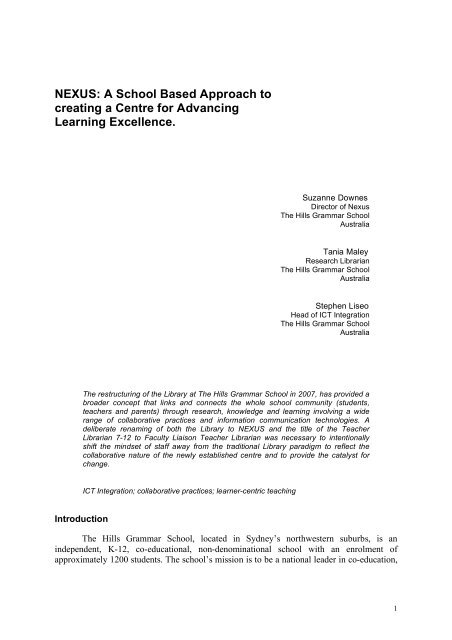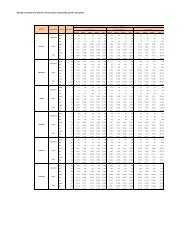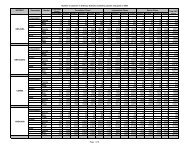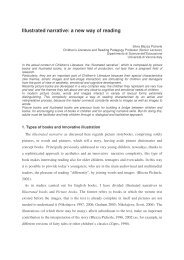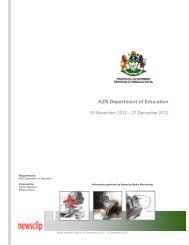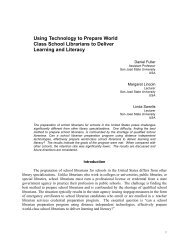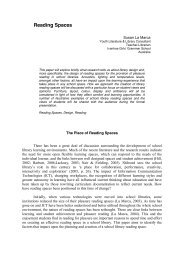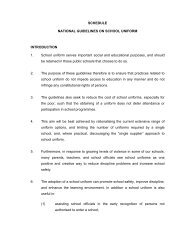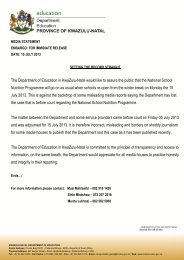IASL FINAL Paper - KZN Education
IASL FINAL Paper - KZN Education
IASL FINAL Paper - KZN Education
You also want an ePaper? Increase the reach of your titles
YUMPU automatically turns print PDFs into web optimized ePapers that Google loves.
NEXUS: A School Based Approach to<br />
creating a Centre for Advancing<br />
Learning Excellence.<br />
Suzanne Downes<br />
Director of Nexus<br />
The Hills Grammar School<br />
Australia<br />
Tania Maley<br />
Research Librarian<br />
The Hills Grammar School<br />
Australia<br />
Stephen Liseo<br />
Head of ICT Integration<br />
The Hills Grammar School<br />
Australia<br />
The restructuring of the Library at The Hills Grammar School in 2007, has provided a<br />
broader concept that links and connects the whole school community (students,<br />
teachers and parents) through research, knowledge and learning involving a wide<br />
range of collaborative practices and information communication technologies. A<br />
deliberate renaming of both the Library to NEXUS and the title of the Teacher<br />
Librarian 7-12 to Faculty Liaison Teacher Librarian was necessary to intentionally<br />
shift the mindset of staff away from the traditional Library paradigm to reflect the<br />
collaborative nature of the newly established centre and to provide the catalyst for<br />
change.<br />
ICT Integration; collaborative practices; learner-centric teaching<br />
Introduction<br />
The Hills Grammar School, located in Sydney’s northwestern suburbs, is an<br />
independent, K-12, co-educational, non-denominational school with an enrolment of<br />
approximately 1200 students. The school’s mission is to be a national leader in co-education,<br />
1
at the forefront of educational endeavour, where each student is encouraged to strive for<br />
excellence in scholarship, personal development and citizenship.<br />
In moving towards this realisation, a review of our K-12 Library was conducted in<br />
2006 to measure the strength of our school library as compared to other competitive leading<br />
independent schools in Sydney. The findings highlighted the falling use of the facilities and<br />
resources in our library by both senior school (Years 7-12) students and staff and a real need<br />
to move forward to meet the ever increasing challenges of education in the 21 st century. Some<br />
research suggests that the impact of the school library diminishes as students move through<br />
high school (Burks 1999; Lance 2001b). As a result, the unique opportunity arose to make a<br />
positive intervention designed to enhance student learning and raise the profile of the school<br />
library. At the start of the 2007 school year, with the Principal’s full support for the initiative,<br />
the Library Department was restructured to include specialised Information Technology<br />
services, by combining the expertise and provisions of the existing Library with those of the<br />
ICT Department. This new vision, to replace the old Library paradigm, involved the<br />
establishment of a centre, NEXUS, to focus on new ways of learning, knowledge creation<br />
and research skills while maintaining library services as a component. The programs<br />
currently on offer within NEXUS include:<br />
K-4 Library Program<br />
Information Literacy Years 5-12<br />
Information Technology Integration Years 7-12, including Multi-Media<br />
Professional Learning K-12<br />
Scholarship Program Years 7-12<br />
Careers and Tertiary Awareness<br />
Online Learning<br />
As the school library research builds, we see strong and compelling evidence that<br />
school libraries are engaging places in the lives of our students, and at the same time we see<br />
challenges ahead where much needs to be done. These challenges take us beyond traditional<br />
notions of the 3 R’s (reading, writing, and numeracy), as long standing conceptions of<br />
information literacy. They focus our thinking on building a knowledge-based society, and the<br />
understandings and actions that will enable our students to get there. The challenge for us is<br />
to shift the emphasis from information centric to embrace a powerful vision of knowledge<br />
centric. This is a whole school approach with support needed by all stakeholders to ensure the<br />
best learning opportunities are provided for our students. This paper focuses on exploring the<br />
pedagogical challenge presented: how can we achieve this?<br />
Rationale<br />
In order to facilitate curriculum practices which establish closer connections and<br />
collaborative practices between Library services and classroom teachers, NEXUS has<br />
integrated ICT into teaching programs to strengthen resource-based enquiry learning by<br />
promoting active learning through students’ confrontation with information resources. This<br />
2
integrated approach allows us to guide students meaningfully through their information<br />
inquiries to develop deep knowledge and deep understanding of their topics.<br />
Information communication technology (ICT) provides unprecedented opportunity for<br />
collaboration, autonomous work and cross-curricular projects. The knowledge economy<br />
dictates that we, as educators, need to continually remain informed of new technologies and<br />
their implications in the educational environment. We are entering a new interconnected,<br />
networked world where more and more people are gaining access to the Web and its ever<br />
growing body of knowledge. Its effects, in an educational context, inspire and challenge us,<br />
as teachers, to think differently about our classrooms and the potentials of the new digital<br />
technologies in terms of pedagogy and curriculum. Research acknowledges the work of the<br />
classroom teacher is greatly enhanced when they can collaborate with an information<br />
specialist in their planning of curriculum and associated assessment tasks. A major<br />
component of this ICT Integration program has been the professional development and<br />
training of staff in the planning, preparation and presentation of lessons using blogs, forums,<br />
wikis, podcasts and many of the emerging Web 2.0 technologies. Liseo has been able to<br />
measure and monitor the levels of skill development and subsequent integration of ICTs into<br />
program development of the participating staff at The Hills Grammar School. Teachers have<br />
to be prepared for questions relating to students’ ICT use and those that related specifically to<br />
the subject content whilst applying Information Literacy elements to their work. This increase<br />
in knowledge, skills and understanding shows direct transference into the variety of new<br />
learning opportunities these teachers can now provide to cater for the diverse range of student<br />
abilities and learning styles of their students. It also underpins all teaching and learning<br />
programs as teachers see ways to directly link ICT integration to syllabus outcomes and<br />
assessment tasks. It is this shift in thinking that has been so exciting and rewarding. From the<br />
outset, it was recognised that in order to be successful, we had to take a collaborative<br />
approach to teaching and a constructivist approach to learning. There is no doubt that<br />
constructivism has had a marked impact on teaching and learning practice. This theory<br />
suggests that in learning, students build on what they already know and actively immerse<br />
themselves with a range of resources.<br />
To support the notion of strong collaboration, the job description and subsequent title<br />
of our traditional teacher librarian (Teacher Librarian 7-12) was intentionally restructured to<br />
typify the more contemporary and evolving role of faculty liaison. Through this partnership,<br />
our newly titled Faculty Liaison Teacher Librarian is in a better position to identify<br />
opportunities for learning and improve access to information. The shift from a content-based<br />
education to an outcomes-based education also moves the focus from what students have<br />
been taught to what they have learned in terms of knowledge, skills and understandings.<br />
These changes in approaches to teaching and learning have required school librarians to<br />
adopt a more outcomes-focused practice and a focus on information literacy as opposed to a<br />
collections-based practice. Incorporating the role of Head of ICT Integration into the<br />
traditional Library paradigm has led the shift away from the stereotypical input such as,<br />
isolated library skill sets, selection of general resources, audiovisual facilities towards more<br />
meaningful input into user needs through information literacy and inquiry, multimedia and<br />
the development of new digital literacies, collaboration and curriculum integration. Students<br />
need to be actively involved in discovering and constructing their new understandings to<br />
meet both the curriculum outcomes and content standards.<br />
To provide this collaborative context for the delivery of educational programs and to<br />
address the falling use of the Library by senior school students and staff, students in Years 7-<br />
9 were allocated a mandatory fortnightly lesson in NEXUS as either an additional English<br />
3
lesson (Year 7) or Science lesson (Years 8/9) per timetabled cycle. This has allowed NEXUS<br />
Centre professionals and teachers to work together to integrate information resources and<br />
ICTs into their teaching programs. It was agreed that information literacy does not exist in a<br />
vacuum and for real learning to occur, information skills must emerge from the subject areas<br />
in which they are embedded. Information literacy provides the framework for recognising the<br />
need for, locating, evaluating and using information. Information literacy is the ability to<br />
confidently define, locate, and critically use information across a broad range of information<br />
sources and technologies. By working collaboratively, our goal was to bring together the<br />
specialised skills of the information professionals with the rigorous subject understandings<br />
and disciplinary knowledge and skills of classroom teachers.<br />
An Action Research model was used to evaluate the success of establishing a collaborative<br />
working environment between subject teachers and NEXUS professionals for Year 7 English<br />
students. Further to the collaborative study, is the creation of assessment tools for tracking<br />
and assessing student learning outcomes in information literacy skills. This has led to the<br />
development of an operational skills program that can be utilized across faculties and will<br />
verify the success of the collaboratively devised information literacy program. Whilst we<br />
have established a Centre to advance learning excellence, we are mindful that we are merely<br />
a ‘connection’ or ‘link’ to what is happening in the classroom and in the computer lab.<br />
NEXUS is a springboard from which to leap into collaboration and best teaching practice<br />
whilst concurrently, raising the profile and prestige of our often under-rated library<br />
professionals.<br />
Methodology<br />
Having identified a need for pedagogical change, to determine the success of these<br />
jointly planned, integrated Literacy lessons and whether there had been any significant<br />
growth in information literacy skills development, an Action Research methodology was<br />
used. We chose this methodology as it is often used in education to review existing practice<br />
with the view to improvement and is a tool frequently used to facilitate change. Being a<br />
cyclic process where action and critical reflection occur in turn, it afforded the opportunities<br />
to explore and test new ideas and assess the effectiveness of these. With the Year 7 English<br />
classes, the focus was more so, to determine the change in student learning whereas with the<br />
Years 8/9 Science classes, the aim was to determine the change in the delivery and mode of<br />
teaching, whilst recognizing that both areas overlap.<br />
Schutz (2006) discusses Action Research as a valuable tool that indirectly improves<br />
student learning outcomes in information literacy. The report focuses on teaching staff<br />
gaining an understanding of the importance of collaboration between themselves and Library<br />
staff and the need for them to familiarise themselves with information literacy skills. These<br />
findings directly relate to this research which has found many teachers are uncomfortable<br />
with the teaching of information literacy and do not recognise the significance of information<br />
literacy skills as a prerequisite for lifelong learning.<br />
Todd (2001) states the importance of Action Research in school libraries as a crucial<br />
tool for raising the profile of the Library/Information Services centre. This, too, is an<br />
important outcome for NEXUS. Todd (2002a, 2002b, 2002c) makes a strong case for<br />
librarians to undertake action research of their own, focusing on the key question of how the<br />
quality of student learning in their particular schools could be improved.<br />
4
Action Research Model<br />
Department <strong>Education</strong> & Training<br />
https://www.det.nsw.edu.au/proflearn/research/actres.htm<br />
Action Research is a social process for research, learning, action and reflection where<br />
the author acts as a Process Consultant, engaging in dialogue to encourage participants'<br />
cooperation, active participation and self-reflection according to Zuber-Skerritt (1991) and<br />
Masters (Masters, 2001).<br />
This project draws on the practical application of Action Research which involves<br />
changes to the participants’ awareness as well as change in social practices.<br />
The following outline for Action Research is based on ‘A thematic concern and four<br />
moments of Action Research’, whereby four fundamental aspects of Action Research were<br />
identified for this study:<br />
The development of a critically informed action plan is essential to improve existing<br />
practices because it provides an environment that supports collaborative practices<br />
through theoretical and practical discussion. The anticipated outcome will be a shared<br />
discourse in which participants can analyse the situation to further develop and<br />
improve their knowledge and actions.<br />
The Action Plan is implemented as a controlled practice. The action taken is observed<br />
and analysed which then forms the basis or starting point for developing the program.<br />
The plan needs to take into account the progressive needs of the students and teaching<br />
staff. Therefore, the plan needs to be suitably flexible and adaptive to accommodate<br />
any unanticipated outcomes. Risks that need to be considered include the potential<br />
effects of social change on existing teaching programs and classroom practice; and,<br />
the political dynamics which may arise within faculties and also between NEXUS<br />
professionals and teaching staff. A journal should be maintained throughout this<br />
process to record feelings, ideas, experiences, attitudes, comments and unexpected<br />
observations.<br />
5
A critical aspect of Action Research depends on the researcher(s) being aware of the<br />
intended consequences and thus able to consider any unintended consequences,<br />
circumstances and constraints that arise from even the best planned Action Research<br />
implementation. Reflection on implementation needs to be followed by thoughtful<br />
discussion of how to further develop the plan to improve existing practices.<br />
Of the five Year 7 English classes, specifically timetabled into NEXUS for one lesson<br />
per fortnight, four were selected for this study. This cohort numbered close to 100 students<br />
however, the top Honour class students were not involved. The methodology used for this<br />
research is based on the NSW Department of <strong>Education</strong>’s, ‘Exploring a standards-referenced<br />
approach for assessment in the new HSC-School based program in the school with a<br />
classroom colleague’ 1 . The learning package was devised for secondary teacher-librarians to<br />
engage with the information supporting Assessment for the New HSC. The aim of the NSW<br />
Department of <strong>Education</strong> is to undertake a collaborative project based on the principles of<br />
action learning to develop quality assessment tasks for Stage 6 (Years 11 & 12). For the<br />
purpose of this study, this model was used as a guide and adapted for our use with Stage 4<br />
(Years 7 & 8) students.<br />
The approach was to embed the teaching of Information Literacy skills, as prescribed<br />
by the NSW Board of Studies English syllabus, into the class teacher’s subject content and<br />
related assessment tasks, using the abovementioned NSW Department of <strong>Education</strong><br />
assessment framework. The inclusion of information literacy skills development in teaching<br />
programs within schools is now a stated requirement in all Key Learning Area curriculum<br />
documents by the NSW Board of Studies (BoS). Unfortunately, the BoS has not provided any<br />
guidelines that define information literacy. The Council of Australian University Librarians<br />
(CAUL) published an accepted definition of information literacy for educational institutions,<br />
including secondary schools, which has been adopted for the purpose of this paper. The<br />
CAUL (2001) definition of information literacy is when a person is able to:<br />
Recognise a need for information<br />
Determine the extent of information needed<br />
Access the needed information efficiently<br />
Evaluate the information and its sources<br />
Incorporate selected information into their knowledge base<br />
Use information effectively to accomplish a purpose<br />
Understand economic, legal, social and cultural issues in the use of information<br />
Access and use information ethically and legally<br />
Classify, store, manipulate and redraft information collected or generated<br />
Recognise information literacy as a prerequisite for lifelong learning.<br />
1 http://www.schools.nsw.edu.au/schoollibraries/teaching/schfocus.htm. (accessed on 23/08/2007)<br />
6
To measure and evaluate the improvement in the students’ levels of information<br />
literacy skills through collaborative planning, programming and teaching of lessons between<br />
the Year 7 English teacher(s) and assigned NEXUS teaching staff, and to concurrently<br />
measure the effectiveness of the teaching and the improvement in student learning outcomes,<br />
a tool was devised by Maley, as part of her Master of Knowledge Management research, to<br />
assess students’ entry and exit information literacy skills based on the assumption that<br />
information literate students understand how knowledge is organised and how to effectively<br />
use information to learn. (This cohort will be tracked and monitored in subsequent years).<br />
The objectives of the project were:<br />
To identify and extrapolate the relevant Information Literacy standards component of<br />
the Stage 4 English Syllabus curriculum outcomes and integrate these with the lesson<br />
content;<br />
To devise a defined set of marking criteria to assess Year 7 students’ Information<br />
Literacy skills (pre- and post-instruction);<br />
To conduct an evaluative study to monitor and track any significant changes to Year 7<br />
students’ Information Literacy skills.<br />
To identify the elements that support successful collaboration between colleagues.<br />
Following discussions with the then Head of Teaching & Learning 7-12 (also<br />
Technology teacher for Years 7-12 and former Head of Technology & Applied Sciences), it<br />
was noted that Year 7 students were already technologically savvy upon entry to Senior<br />
School and in many cases, their level of Information Technology literacy surpassed the Board<br />
of Studies (BoS) outcomes. From these initial discussions, it also emerged that classroom<br />
teachers were not comfortable with teaching information literacy because they did not<br />
understand its context and could not integrate the skills into their subject outcomes. Given<br />
their confusion, it is unlikely that successful programs could be developed in isolation by<br />
either classroom teachers or indeed, teacher librarians. It became apparent that programming<br />
needed to be constructed in joint collaboration with clearly defined information literacy<br />
standards to be taught.<br />
Kuhlthau and Todd (1996) discuss guided inquiry as a carefully planned approach to<br />
teaching conducted by teachers and librarians. This approach pre-supposes that collaboration<br />
is an established part of the teaching process. The theory of guided inquiry, in practise, will<br />
be a deeper collaborative approach between classroom teachers and NEXUS staff. Guided<br />
inquiry is planned, supervised targeted intervention by an instructional team of school<br />
librarians and teachers who guide students through curriculum units that build meaningful<br />
knowledge that steadily leads to independent learning (Kuhlthau 2007). Gawith (2005, as<br />
cited in Heinstrom & Todd) discusses inquiry learning as encouraging students to ask<br />
questions, discover new ideas and critically analyse their findings.<br />
Collaborative Practices<br />
The Action Research model commenced with initial discussions between the English<br />
Faculty (Year 7 English teacher) and the Research Librarian at the beginning of the school<br />
year to decide on how best to meet the integrated Stage 4 outcomes for English and<br />
7
Information Literacy. The key objective of the initial round of assessments was to determine<br />
the base level of information literacy skills of the incoming Year 7 students so that a specific<br />
program could be devised with incremental levels of proficiency to increase students’ skills,<br />
taking into account the students’ intellectual growth and maturity over the school year.<br />
Concurrently, marking criteria for assessment had to measure the students’ information<br />
literacy skills development against their intellectual growth and maturity over the school<br />
year.<br />
Of the five Year 7 English classes, the Honours class (comprising gifted and talented<br />
students in Humanities) was not involved in these assessments. This class worked from a<br />
differentiated curriculum, at an accelerated level and as the NEXUS Information Literacy<br />
(IL) program did not meet their specific needs, the integration of IL outcomes for the<br />
Honours class was the task of their assigned English teacher. The four other English<br />
classroom teachers supported their students’ participation in the collaborative program.<br />
Heinstrom and Todd (2006) discuss the importance of identifying an approach to a<br />
curriculum topic that students can relate to and as a consequence, are motivated to increase<br />
their depth of learning. Therefore, the collaborative process between the classroom teacher(s)<br />
and Nexus professional(s) was to develop rich tasks to stimulate, motivate and improve<br />
student learning. Teaching students in a technology environment provided a comfortable and<br />
familiar platform from which to launch into inquiry learning. The guided inquiry approach<br />
used in this Action Research report meets with content and standards requirements as set by<br />
the Board of Studies. The syllabus states:<br />
‘English in Years 7-10 is both challenging and enjoyable. It develops skills to enable<br />
students to experiment with ideas and expression, to become active, independent learners, to<br />
work with each other and to reflect on their learning.’<br />
A critical question that needs to be defined and answered is what exactly do we mean<br />
by ‘collaboration’?<br />
Collaboration is a network of interdependent elements and is explained in the concept<br />
of curriculum alignment (CAUL, 2001). The ‘web of consistency’ can be applied to any<br />
discipline and/or topic area and information literacy skills can be assessed within that context.<br />
Collaboration has a truly great effect on improving students’ academic learning when<br />
innovation coupled with creativity is applied to the mix.<br />
The model below can be used to represent collaboration and the elements that support<br />
successful collaboration.<br />
Assessment<br />
Curriculum Alignment Model<br />
8
Learning<br />
Outcomes<br />
Evaluation<br />
Objectives<br />
Content<br />
Curriculum<br />
Teaching Methods<br />
T & L activities<br />
Figure : The curriculum alignment model displays the alignment between goals, objectives,<br />
content, learning outcomes, teaching methods, teaching and learning activities, assessment and<br />
evaluation relevant to collaboration in education (CAUL, 2001).<br />
The theories advocated in the literature reviewed for this project highlighted the<br />
benefits of collaborative teaching between subject teachers and NEXUS professionals which<br />
include but are not limited to:<br />
A positive attitude to the inclusion of and the teaching of Information Literacy skills<br />
in their English teaching programs by the classroom teachers<br />
Motivation and support for classroom teachers to take responsibility for their own<br />
professional development in the use of and integration of ICTs in their teaching<br />
programs<br />
A desire to develop rich learning tasks and deep learning outcomes through resourcebased<br />
learning tasks to motivate students and improve student learning outcomes<br />
The opportunity this provides to showcase the facilities and programs on offer within<br />
NEXUS to the wider School community thus raising its profile.<br />
9
Administration of Assessment Tasks<br />
Assessment Task 1<br />
This first assessment task was designed to focus on how well the students identified<br />
and retrieved information and was conducted in Week 3 of Term 1. The information the<br />
students were asked to find was based on the Year 7 Scope and Sequence strand ‘Growing<br />
Up’, covering difference and diversity. In English, they were studying the novel, ‘Little<br />
Brother’, by Allan Baillie (1995) which provided the context for the program. Students had<br />
two one-hour lessons in which to complete their task.<br />
The first assessment was administered to the four Year 7 English classes by their<br />
assigned English teacher and the Research Librarian who, together, team teach these<br />
fortnightly Literacy lessons. After analysing the results of the initial assessment task, some<br />
Year 7 teachers were not as enthusiastic as they had earlier been. Their concerns were that<br />
their students were not able to understand all the questions, for example, the instruction to<br />
locate different websites ending with .org or .edu. Another teacher was unsure about the<br />
amount of time it would take to complete the task, feeling it would take longer than the two<br />
lessons allocated, and expressed their concern that the students would lose focus. Most<br />
teachers were interested to observe their students’ behavioural and assessment outcomes at<br />
the culmination of the second lesson, and keen to learn how able they were at identifying and<br />
retrieving information. The marking of the assessment task was divided into two sections,<br />
with the core English content being marked by the subject teacher and scores recorded before<br />
the Research Librarian marked the Information Literacy component. These marks were not<br />
recorded on the students’ assessment but instead used to determine the baseline level of<br />
information literacy skills that would enable collaborating teachers in the English faculty and<br />
NEXUS staff to design an IL Program for Year 7 entry.<br />
The assessment task comprised three levels of scoring: Developing, Satisfactory and<br />
Achieving. Students who failed to answer the question correctly or whose answers did not<br />
address the question were put into the Developing category, requiring further support<br />
(preferably one-to-one intervention). Those who were able to partially answer the question,<br />
demonstrating an understanding but giving an incorrect response, were marked Satisfactory.<br />
Students who answered the question correctly and were able to give an example from the text<br />
were awarded Achieving. The criteria for marking the assessment task was based on the<br />
combination of relevant learning outcomes from both the Board of Studies Stage 4 English<br />
Syllabus and the CAUL Information Literacy standards.<br />
10
Assessment 1<br />
% Correct<br />
100%<br />
80%<br />
60%<br />
40%<br />
20%<br />
Percentage Achieving<br />
Percentage Satisfactory<br />
Percentage Developing<br />
0%<br />
1 2 3 4 5 6 7 8 9<br />
Question No.<br />
Table 1: Assessment Task 1 Results<br />
A number of interviews with the English subject teachers were held in person and/or<br />
via e-mail with the Research Librarian. A template was used for question and answer type<br />
dialogue under various headings, such as: What we did; what we learnt about assessment<br />
practices for IL; how can this information be shared/used to improve learning and teaching;<br />
what refinements would we suggest. The extra work load required by teachers to integrate<br />
information literacy skills into their teaching had not been factored into their already busy<br />
schedules and teachers were not given any opportunity to program in these new Literacy<br />
classes (one per fortnight in NEXUS) before the school year began. A better result would<br />
have been achieved if a collaborative plan had been put in place from the outset. Discussion<br />
arose about the importance of developing some type of school based Scope and Sequence for<br />
the integration of Information Literacy skills into each mandatory THGS curriculum<br />
document to track and monitor students’ development through each Stage level. Student<br />
outcomes would then be reported and accounted for appropriately, giving IL the validity in<br />
the School curriculum that it rightly deserves.<br />
The flexibility of the Year 7 Literacy Program, taught collaboratively, offered the<br />
opportunity for joint reflection on what had happened and the chance to make necessary<br />
modifications before the next round of assessments. As both teaching parties were mindful of<br />
the pitfalls that could affect the program, this collaborative approach added to its success.<br />
Other feedback included not only the development of positive relationships between teachers<br />
and NEXUS staff but also in smoothing the boundaries between NEXUS, as a teaching and<br />
learning environment and the classroom for both students and teachers. Teachers began to see<br />
that NEXUS was a further extension of their classroom. The constructivist approach allowed<br />
for goal setting, independent and collaborative learning and active learning with the teacher<br />
and librarian acting as facilitators rather than deliverers of content.<br />
The first assessment task determined the base level of each student and identified a<br />
common weakness in students’ ability to critically evaluate websites as information<br />
resources. This information directed the focus for teaching and formed the subsequent testing<br />
for Assessment Task 2.<br />
11
Coinciding with the first round of testing, the Head of ICT Integration, central to the<br />
new concept of NEXUS, was conducting training for interested staff on Moodle (an online<br />
teaching and learning web interface tool that allows teachers the flexibility to post lessons,<br />
assessments and homework online). Moodle provides the opportunity for a 24 hour classroom<br />
which, in itself, has brought many new challenges with teaching staff now required to<br />
become more information literate. The introduction of Moodle as a teaching and learning<br />
tool, combined with the introduction of Information Literacy teaching, has given NEXUS a<br />
raised profile within the School community, even at this early stage.<br />
Assessment Task 2<br />
The guided inquiry approach has a greater application to student learning than<br />
knowledge gathering. It is not enough to provide students with sources and instruction in<br />
finding and evaluating information. A more holistic approach where an intervention is<br />
implemented (by the teacher and the librarian) in the information seeking process will<br />
encourage students in their own learning processes. It was anticipated that students would<br />
engage willingly in the learning process if they were motivated by the topic and encouraged<br />
to complete the task in a supportive learning environment. As evidenced, an area that needed<br />
to be developed was the ability to determine the true nature and extent of the information<br />
requested and from this, the ability to critically evaluate the information retrieved. A lesson<br />
prior to the second assessment task, administered in Week 7 of Term 1, focused on how to<br />
differentiate between good and bad websites.<br />
Assessment 2 - Sheet 1<br />
% Questions answered<br />
correctly<br />
20<br />
15<br />
10<br />
5<br />
0<br />
Q1 Q2 Q3 Q4 Q5 Q6 Q7 Q8<br />
Achieved<br />
Satisfactory<br />
Developing<br />
Question no.<br />
Assessment 2 - Sheet 2<br />
% Questions answered<br />
correctly<br />
80%<br />
70%<br />
60%<br />
50%<br />
40%<br />
30%<br />
20%<br />
10%<br />
0%<br />
Q1 Q2 Q3 Q4 Q5 Q6 Q7 Q8<br />
Achieved<br />
Satisfactory<br />
Developing<br />
Question nos.<br />
12
The assessment task was again based on the novel, ‘Little Brother’, by Allan Baillie<br />
(1995) and these questions related to the Board of Studies English syllabus outcomes 1.5 and<br />
1.6 and CAUL Information Literacy Standards 2 and 3. Although some students experienced<br />
difficulties identifying elements that define good quality websites and also experienced<br />
difficulty critically evaluating information on a website, this assessment task was successful<br />
for two teachers who noted that students were able to demonstrate transference of their newly<br />
acquired skills to the classroom situation and they were excited about participating in lessons<br />
held in NEXUS. Students need to be actively involved in discovering and constructing their<br />
new understandings to meet curriculum outcomes and content standards and given<br />
opportunities to show transference of their newly acquired skills and knowledge to new<br />
situations. The collaborative English information literacy lessons developed an intrinsic<br />
motivation to research independently and encouraged positive self-efficacy about accessing<br />
and using resources. Not all went smoothly though with the other two groups as one teacher<br />
arrived with the class at the beginning of the second lesson and advised the Research<br />
Librarian that the class would not be following the planned Information Literacy program.<br />
The students were not coping with the online literacy assessment task so the teacher had<br />
prepared her own program for the class to follow. The fourth teacher in the program also<br />
opted out because the students were finding the tasks challenging and their motivation to<br />
finish was extremely low.<br />
Assessment Task 3<br />
By this stage, students had undergone two terms of information literacy teaching in<br />
NEXUS. The collaborative approach ceased to operate due to staffing changes in both the<br />
English Faculty and NEXUS. Whilst there was knowledge sharing between the English<br />
Department and NEXUS about the topics students were studying, there was no longer the<br />
collaborative approach to program design and delivery of these lessons. Students read the<br />
play ‘Two Weeks with the Queen’ by Mary Morris, adapted from the novel by Morris<br />
Gleitzman (1993) for the drama topic and the gender theme. For the final round of<br />
information literacy testing, students were given two texts in their information literacy class:<br />
a portion of ‘Aung-San’ by Elizabeth Arnold (2007) and a scene from the play ‘Boss of the<br />
Pool’ by Mary Morris, adapted from the novel by Robin Klein (1993). Both texts shared the<br />
same themes as the first two assessment tasks: gender; difference and family.<br />
In Assessment Task 3, students were asked to answer a multiple question activity and<br />
open-ended responses about the two text types using the online teaching and learning<br />
software, Moodle, which focused on critical analysis skills. As Moodle was new to students,<br />
the Teacher Librarian gave a tutorial prior to the assessment task whereby students were<br />
given the opportunity to answer two ‘dummy’ questions as a practice beforehand.<br />
The student outcomes were not as strong as Assessment 2. The majority of students<br />
did not understand ‘text type’ or ‘genre’ or how to recognize the author’s name. These<br />
questions met BoS English Syllabus Outcome 1.6 where students need to categorise texts by<br />
content, genre, composer and purpose and CAUL Information Literacy Standard 3 that states<br />
information literate people are able to summarise the main ideas extracted from information<br />
gathered. In discussion, it was evident that English teachers find it difficult to teach<br />
Information Literacy as part of their English classes. One reason is because the teacher that<br />
students have for their regular English lessons may not necessarily be the same allocated to<br />
their class for the extra fortnightly Information Literacy classes. Due to this awkward<br />
situation, problems have arisen with consistency and continuity of programs. Some teachers<br />
13
are keen for information literacy skills to be taught in conjunction with their subject.<br />
However, if there is only one lesson every two weeks, it is difficult to integrate information<br />
literacy lessons with what is being taught in the classroom and maintain consistency. The<br />
English faculty tend to move through topics within the two week timeframe, so the<br />
opportunity for teaching information literacy skills linked to the topic is often lost. One<br />
teacher even commented that she did not understand what information literacy was and why<br />
it had to be part of the English syllabus. By the third assessment task, signs of political and<br />
social change began to impact negatively on the collaborative approach.<br />
Conclusion and Recommendations<br />
This research project has provided evidence-based practice demonstrating the tangible<br />
impacts and outcomes of making sound decisions through the implementation of NEXUS<br />
goals. The documentation of the learning outcomes of these collaborative teaching-learning<br />
lessons has helped to validate the school library to the wider school community, and the<br />
learning that is enabled through it. This study showed that initially teachers were not only<br />
unsure about what information literacy meant, therefore unable to plan for its inclusion in<br />
curriculum outcomes, but were also somewhat reticent to hand over ownership of their<br />
students or the delivery of lessons in a team teaching approach. The number of students<br />
assessed in this research project only totalled 19 out of 125 students in Year 7. By<br />
introducing a collaborative approach, teachers were forced to share their valuable teaching<br />
time with an Information professional who, unlike the classroom teacher, had no<br />
accountability for students’ learning outcomes in terms of the assessment and reporting cycle.<br />
Hence there was very little incentive for teachers to become part of a program such as this<br />
one, where the full responsibility remained with the teacher yet the expectation was for class<br />
teachers to entrust their students’ learning to someone else. It was evident that teachers were<br />
comfortable when using NEXUS facilities to teach their own classes, but were not so<br />
comfortable in sharing a collaborative teaching approach where they had to take the full<br />
responsibility for information literacy outcomes when they did not understand these<br />
themselves. To avoid some of the issues that arose, a professional relationship needs to be<br />
established between the faculties so collaboration becomes an accepted part of lesson<br />
planning, implementation and evaluation. A major shift in thinking is needed to promote and<br />
facilitate such collaborative practice at The Hills Grammar School.<br />
From observation and discussion of this research, there are indications that teaching<br />
staff can move forward to embrace change, but the change needs to be supported through<br />
School Management. A top down approach will cause shift, not always willingly, but it will<br />
impact on existing approaches. This project explores the successes and pitfalls, highs and<br />
lows, joy and exasperation of initiating new ways of presenting learner-centric teaching.<br />
The Hills Grammar School is justifiably proud of the fact that every individual in the<br />
School is valued. The School caters for a large range of abilities and learning styles among<br />
the students. We need to be open to different ways of thinking, processing and interpreting<br />
the world. We must observe, listen, have an awareness of current theories and frameworks<br />
but not ruled or constrained by them. From our NEXUS team’s viewpoint this is the<br />
challenge, excitement and frustration of our job. If the cap fits, wear it; if it does not, try a<br />
new cap, change the old cap, design a new cap or go bare-headed! In NEXUS, our approach<br />
incorporates these considerations and seeks to use the most effective teaching strategies in<br />
order to engage each student in his/her learning.<br />
14
In an atmosphere of collaboration we can continually encourage the students to<br />
expand their capabilities and foster confidence as a learner. We endeavour to demonstrate,<br />
through our daily interaction with students, a way of teaching that inspires success and a love<br />
of learning that will last them all their lives.<br />
15
References<br />
Bruce, C. (1997). Seven Faces of Information Literacy. AUSLIB Press, Adelaide, South Australia<br />
Burks, F. (1999). ‘Student Use of School Library Media Centers in Selected High Schools in Greater Dallas-<br />
Fort Worth’, School Library Media Quarterly, vol. 24, no 3.<br />
CAUL Information Literacy Standards. (2001). Council of Australian University Librarians, Canberra, ACT<br />
Entwistle, T. (2000). ‘Promoting deep learning through teaching and assessment: Conceptual frameworks and<br />
educational contexts’, paper presented at TLRP Conference, Leicester, UK (accessed 7 September<br />
2007).<br />
http://66.102.1.104/scholar?hl=en&lr=&as_qdr=all&q=cache:EAE3GVwRyHMJ:www.tlrp.org/pub/acadpub/En<br />
twistle2000.pdf+Tait+Entwistle+education+%22ASSIST%22<br />
Gawith,G. (2005). ‘Information Literacy and Inquiry’, Good Teacher, Term 1, 2005. In Heinstrom, J & Todd, R.<br />
(ed.) ‘Uncertainty and guidance: school students’ feelings, study approaches, and need for help in<br />
inquiry projects’, Scan, vol. 25, no. 3, August, 2006<br />
Gordon, C. (2000). ‘Information Literacy in Action’, John Catt <strong>Education</strong>al Ltd, Suffolk, UK<br />
Henri, J and Asselin, M. (eds.). (1999). ‘The Information Literate School Community 1: Best Practice’, Charles<br />
Sturt University, Centre for Information Studies, Wagga Wagga, NSW<br />
Henri, J and Asselin, M. (eds.). (2005). ‘The Information Literate School Community 2: Issues of Leadership’,<br />
Charles Sturt University, Centre for Information Studies. Wagga Wagga, NSW<br />
Heinstrom, J., and Todd, R. (2006). ‘Uncertainty and guidance: school students’ feelings, study approaches, and<br />
need for help in inquiry projects’, Scan, vol 25, no. 3. August, 2006<br />
Kuhlthau, C (ed). (1994). ‘Assessment and the School Library Media Centre’, Libraries Unlimited Inc.<br />
Englewood, Colorado<br />
Kuhlthau, C and Todd, R. (2007). ‘Guided Inquiry’, Centre for International Scholarship in School Libraries<br />
(CISSL), Rutgers University, http://www.cissl.rutgers.edu/guided_inquiry/introduction.html (accessed<br />
10 October 2007).<br />
Lance, K.C. (2001b). ‘Good Schools Have School Librarians: Oregon School Libraries Collaborate to Improve<br />
Academic Achievement’, Oregon <strong>Education</strong>al Media Association.<br />
Lunsford, K.J., and Bruce, C. (2001). ‘Collaboratories: working together on the web’, cited in Henri, J and<br />
Asselin M (eds.) 2005, ‘The Information Literate School Community 2: Issues of Leadership’, in<br />
Australian Teacher Librarianship, no. 5, CIS, Wagga, Wagga, NSW<br />
Masters, J. (2001). ‘The History of Action Research’, Action research e-Reports, 3, Accessed 11 November<br />
2007. http://www.fhs.usyd.edu.au/arow/arer/003.htm<br />
McTaggart, R. (1992). Action Research: Issues in theory and practice, paper presented to Methodological Issues<br />
in Qualitative Health Research Conference, Deakin University (accessed 3/10/07).<br />
http://www2.fhs.usyd.edu.au/arow/o/m01/rintro.htm<br />
NSW Board of Studies. (2003). ‘English Years 7-10 Syllabus’, Board of Studies, NSW<br />
NSW Board of Studies. (2003) ‘Science Years 7-10 Syllabus’, Board of Studies, NSW<br />
NSW Department of <strong>Education</strong> and Training. School Libraries and Information Literacy, Sydney, NSW<br />
(accessed 9 November 2007).<br />
http://www.schools.nsw.edu.au/schoollibraries/teaching/resource.htm<br />
16
Oberg, D. (ed.). (2005). ‘School Libraries Worldwide: Theory, Research Practice’. International Association of<br />
School Librarianship (<strong>IASL</strong>), Zillmere, Queensland<br />
Rearick, M., and Feldman, A. (1999). ‘A Framework for Understanding Action Research’ (accessed 2/11/07)<br />
http://www.unix.oit.umass.edu/~afeldman/Action Research<strong>Paper</strong>s/RearickFeldman1999.PDF<br />
Schutz, H. (2006). ‘Building Information Literacy: an Action Research Approach’, Scan, vol. 25, no. 4,<br />
November 2006<br />
Todd, R. (1996). ‘Independent Learning and Information Literacy: An Essential Information Partnership for<br />
Learning’, Learning Resourcefully in the Information Age, AUSLIB Press, 1996, pp. 13-18.<br />
Todd, R. (2001). ‘Transitions for Preferred Futures of School Libraries’, keynote paper International<br />
Association of School Librarianship (<strong>IASL</strong>) Conference, Auckland, New Zealand, Virtual Conference<br />
Session, http://www.iasl-slo.org/virtualpaper2001.html (accessed 8 September 2007).<br />
Todd, R. (2002a). ‘Evidence Based Practice: Getting into the Action’, Scan, vol. 21, no. 2, May, pp. 34-41.<br />
Todd, R. (2002b). ‘Evidence Based Practice: The Sustainable Future for Teacher-librarians’, Scan, vol. 21, no.<br />
1, February.<br />
Todd, R. (2002c). ‘School Librarians as Teachers: Learning Outcomes and Evidence-based Practice’, 68 th IFLA<br />
Council and General Conference, Glasgow, August 18-24.<br />
Zuber-Skerritt, O. (1991). ‘Action Research for Change and Development’, Aldershot, England<br />
Statement of Originality<br />
This statement certifies that the paper above is based upon original research undertaken by the<br />
author and that the paper was conceived and written by the author(s) alone and has not been<br />
published elsewhere. All information and ideas from others is referenced.<br />
17


